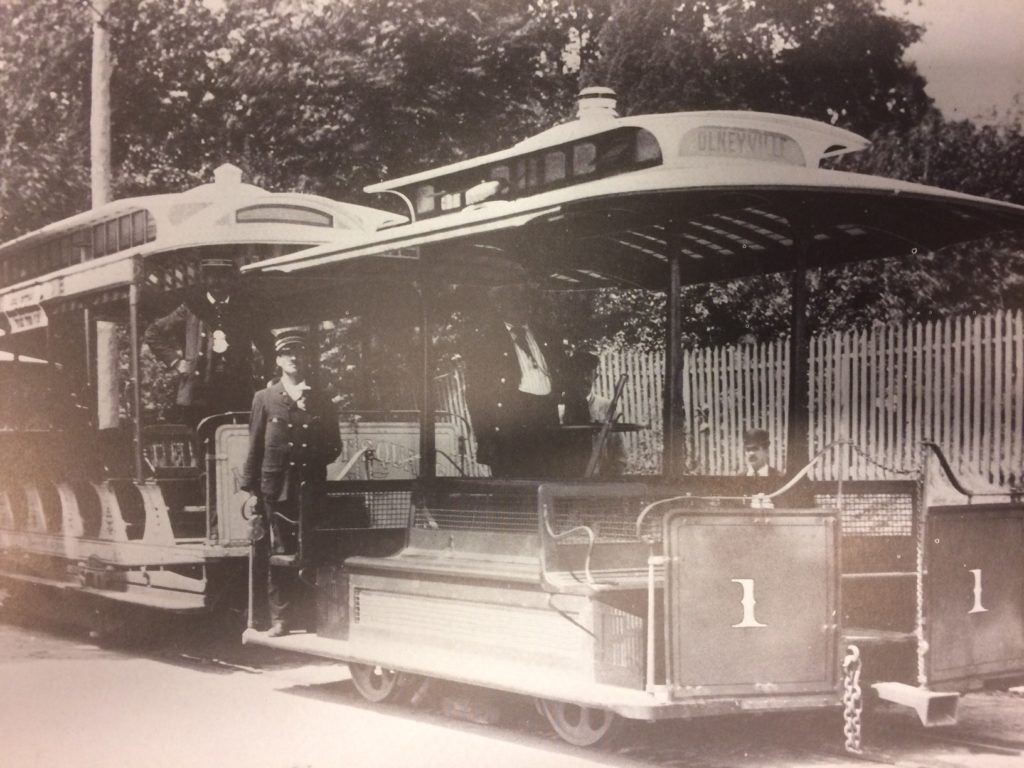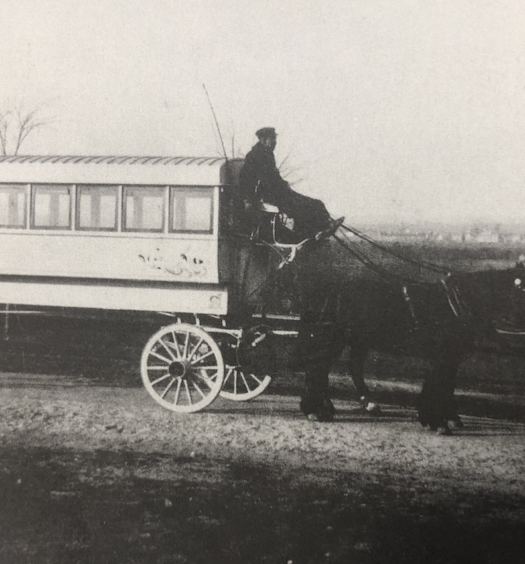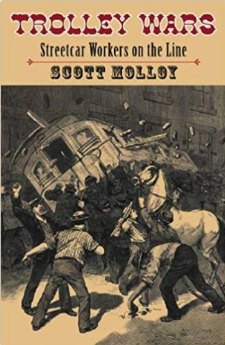Building of the Providence Cable Tramway in 1889 fascinated Rhode Islanders. A power house on South Angell Street, near the Seekonk River, pulled 17,000 feet of cable more than an inch in diameter. The line stretched from the power house beneath the streets of the East Side, down the hill, and extended to the Great Bridge at Washington Row near Market Square. Workers dug a trench six feet wide and five feet deep to house the cable. A series of 400-pound cast iron yokes supported 22-foot lengths of slot rails, spaced one inch apart. A long lever from a grip car fit between the rails to bite the cable which was in constant motion. Rails for the wheels of the, grip and passenger cars straddled the slot rails at standard gauge. Special footings filled the trench for stability and a series of 82 manholes allowed lubrication of gears beneath the street.
Open grip cars could hold an operator (grip man) and eighteen passengers. Each grip car pulled an open or closed trail car. The cable eventually traveled at nine miles per hour. Months before the grand opening Samuel Nightingale offered “Cable Tramway Lots” for sale. The Olneyville Business Men’s Association also jumped the gun and asked for extended tramway service through Olneyville to Plainfield Street in the Silver Lake section of Johnston (not annexed by Providence until 1898). The Union Railroad charged a full fare from Olneyville to Plainfield Street, a very short distance, inadvertently encouraging shoppers to bypass Olneyville merchants and trade Downtown. “The business men of Olneyville want three-cent fares so that their customers will not ride past their stores to the city; the real estate owners want three-cent fares to induce their workers in Olneyville factories to take residence in Johnston.”

Rhode Island was the only New England state to ever feature a San Francisco-type cable car that ran up and down a major hill. This one ran up and down College Hill on the East Side of Providence. Car number one employed a grip handle that reached into the ground to grasp a cable that ran from Red Bridge to Market Square, where horses were attached. The operation only ran from 1890 to 1895 (Scott Molloy Collection, Robert L. Carothers Library (at URI), Special Collections and University Archives)
The Olneyville Business Men’s Association agreed to petition the Johnston Council to vote in favor of the tramway. One member alleged that the Union Railroad went to the council and said: “Here, we’ll give you anything you want if you will shut the Cable road out.” The West Providence Club, a civic organization, voted to endorse cable too. A few weeks later the Union Railroad, spurred by the threat of competition, began laying rails to Silver Lake. One Olneyville store keeper reluctantly backed the Union Railroad saying “he had no fear that the track would be injurious to his trade, but a large number of employees of the Union Company trade with him, and they were all so well treated by their employers that they are eager to have all opposition blocked.” Meanwhile the Providence City Council authorized the cable road to run to the Johnston border adjacent to Olneyville. In December 1889 the cable company installed the eighteen ton cable on the East Side: “Hundreds of -people gathered and curiously watched the operation of the twelve horses yanking the invisible arid supposedly serpent-like cable through the tunnel.”
On December 11, 1889 the Providence Cable Tramway Company ran cars and “the hitherto insurmountable obstacle of the East Side hill had been for the first time conquered.” Thousands lined the streets to cheer the only railway whose principal owners lived along the route. Many availed themselves of a free ride that day and held on tightly as the grip car descended the hill. The company continued to test the cable and provide transportation without cost for several weeks, a stellar public relations performance. One train of cars meant to hold 36 somehow accommodated 130. Meanwhile the tramway prepared stables on Valley Street in Providence near Olneyville for horsecar use. Revenue service over the hill began officially on the first of January, 1890.
There were problems that first year, of course. The cable broke occasionally, a collision between a grip car and a carriage killed a driver, and a Union Railroad horsecar ran into the side of a tramway car. Rhode Island historian Albert Clean remembered that children were always dropping wires and ropes into the cable slot: “many blocks of wood, horse chestnuts, pine cones, pasteboard boxes, tin cans and dead animals traveled up the streets at all hours of the day and night.”
Whatever preliminary problems plagued the new line, an innovative system worked. East Side carriage owners, united in search of higher land values, endorsed tracks in the streets. Walter Richmond proved to be an astute businessman and fierce competitor driven by more than profit. The Providence Board of Trade commented wryly when cable stock spiraled to $103 a share in February, 1890: “Those who had hitherto pooh-poohed the enterprise are astonished, although unwilling to allow that they are.” Even Union Railroad stockholders were purchasing shares as a sound business investment.
In April, 1890, friends honored the tramway founder with a collation at the South Angell Street power house, which had been partially transformed into a pleasant “cottage” for patrons, not unlike Union Railroad facilities at Roger Williams Park. One speaker toasted Richmond for helping reinvigorate Providence which, he felt, had become an “animated graveyard” after the fall of the Spragues and death of Mayor Thomas Doyle.
Within six months the cable carried 40,000 passengers and cut into lucrative Union Railroad traffic to Olneyville. Tramway operators kept the promise of a one fare ride from the Red Bridge. In October 1890 tramway officials asked the city council to authorize an underground cable from Market Square to Olneyville and eliminate rental of Union Railroad tracks. Richmond described cable service as impervious to bad weather and pragmatic for the proposed route. He volunteered to place all police, fire and telephone wires in the cable conduit at no cost to the city. At the next hearing, William Roelker, counsel for the Union Railroad and the Providence Gas Company, thundered: “These petitioners cooly ask your honorable body to confiscate oft property without compensation to us, and give it to them. It is safe to say that no more barefaced and piratical proposition was ever presented to any legislative body.” The tramway brought in outside expert witnesses to testify. Rathbone Gardner, lawyer for the road, offered the greatest threat to Union Railroad hegemony: “I can say today that if the time has come when the Union Railroad does not give acceptable service, the tramway company is ready to put the cable in all streets where cars are now run, and in all others where they ought to run.” Earlier in the year, another group of entrepreneurs incorporated the Pawtucket Cable Tramway to run from Pawtucket through East Avenue and Hope Street to the East Side, a route the Union Railroad had been contemplating.

A counterweight grip car eases a four-wheel East Side electric car down College Street into Market Square, where it will turn the electric loose to continue on the West Side on its own (Collection of R.L. Wonson)
Two weeks after the last contentious hearing and tramway threat to thread the city with underground cable, Union Railroad officials approached the cable company and tendered a bountiful offer to buy the road for $130 a share. Upon agreement, the Union Railroad immediately petitioned the General Assembly to increase capitalization to $3,000,000 and to allow it to hold stock in other companies and lease property of local railways. The cable retained its name. The tramway entrepreneurs, including some of the most powerful citizens in the state, had bested the Union Railroad and made a profit to boot. While the Union Railroad suffered a public defeat, much to the glee of the populace, it purchased a successful road.
The Union Railroad eventually paid top dollar for the cable enterprise but preserved a virtual monopoly on railway service, although other competitors continued to seek an opening. The electrification of service and the added capital expense of that power would discourage even well-heeled investors in the future. For the public, an end to railway rivalry meant an end of competitive pressure that frequently forced the Union Railroad to improve service. The latter soon took political steps to codify the informal control of Providence streets to preclude further interlopers.
Following the introduction of electricity, the tramway changed to a trolley system aided by a underground counterweight for added power to negotiate the hill. The last cable car ran on January 26,1895. Electric cars equipped with only one motor (the cable could not haul two-motor cars because of their weight) assisted each other up and down the hill on a slow and inefficient one-to-one ratio. The counterweight system was soon reengineered to allow former cable cars fitted with electric motors to push trolleys up the still imposing incline.
In 1913-1914 a tunnel beneath College Hill was finally constructed. George Washington allegedly suggested such a solution on one of his visits to the city! Tunnel supporters had actually broken ground in the early 1870s but were overwhelmed by engineering problems. Rhode Island Public Transit Authority buses still use the East Side tunnel today.
[Banner Image: A counterweight grip car eases a four-wheel East Side electric car down College Street into Market Square, where it will turn the electric loose to continue on the West Side on its own (Collection of R.L. Wonson)]

























